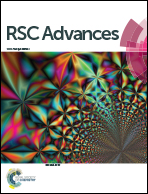Bio-templated fabrication of hierarchically porous WO3 microspheres from lotus pollens for NO gas sensing at low temperatures
Abstract
Lotus pollens were used as templates to prepare WO3 microspheres; the intriguing structural features of the pollens, e.g. hollow sphere with highly porous double shells, were perfectly inherited by the WO3 microspheres. The hierarchically porous structure of the WO3 microspheres was ideal for gas sensing. The WO3 microsphere-based sensor exhibited a high sensitivity (S = 46.2) to 100 ppm NO gas with a pretty fast response and recovery speed (62 s/223 s) at 200 °C. Compared with NO sensors reported in the literature so far, the WO3 microsphere-based sensor has among the highest sensitivity and fastest response/recovery.


 Please wait while we load your content...
Please wait while we load your content...